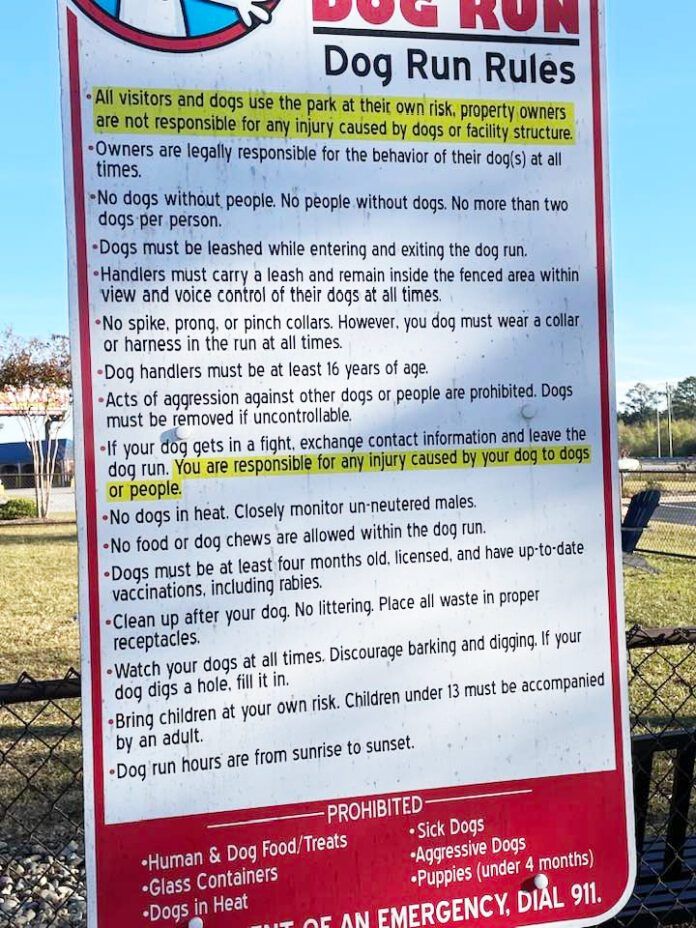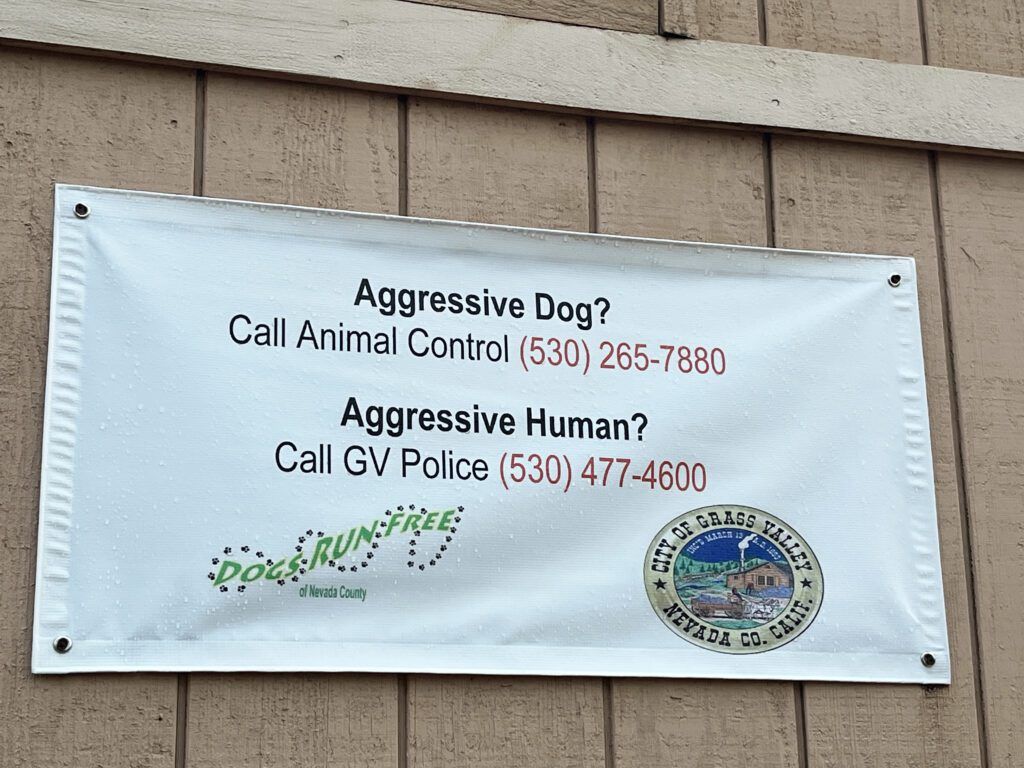
A friend recently posted a photograph she took at a dog park she visited in Roanoke Rapids, North Carolina. Pictured was a sign, posted at the entrance of the dog park, which listed the rules that visitors were supposed to observe at the park. It was a very good list, full of common-sense cautions, and aimed at asking people to observe their dogs at all times and take full responsibility for their dogs’ behavior.
I am a fan of dog-park rules, and I, too, have taken pictures of the posted rules at every dog park I have ever visited, in an effort to see how different communities have responded to the people and dogs there. This sign covered the most important points, I think, although I would debate some of them. (I’ve never seen what I would consider a perfect list of rules; there may be no such thing!)
- All dogs and visitors use the park at their own risk; property owners are not responsible for any injury caused by dogs or facility structure.
- Owners are legally responsible for the behavior of their dog(s) at all times.
- No dogs without people. No people without dogs. No more than two dogs per person.
- Dogs must be leashed while entering and exiting the dog run. (Note: Some parks install a small “airlock” with gates at either end where you can enter with your leashed dog, close the gate behind you, and remove his leash before opening the gate at the other end to let your now-unleashed dog into the park. Upon exiting, you can open the interior gate, enter the airlock with your dog, close it behind you, and put his leash before exiting. This helps you leash and unleash your dog without the distractions of other dogs—and prevents the escape of any dogs who try to slip in or out while you are entering or exiting.)
- Handlers must carry a leash and remain inside the fenced area within view and voice control of their dogs at all times.
- No spike, prong, or pinch collars. However, your dog must wear a collar or harness in the run at all times. (I strongly prefer dogs to play “naked,” to prevent any potential entanglements from dogs grabbing each other’s gear, but I appreciate the necessity of having a “handle” with which to grab a dog in case of a fight.)
- Dog handlers must be at least 16 years of age.
- Acts of aggression against other dogs or people are prohibited. Dogs must be removed if uncontrollable.
- If your dog gets in a fight, exchange contact information and leave the dog run. You are responsible for any injury caused by your dog to dogs or people.
- No dogs in heat. Closely monitor un-neutered males. (I would argue that one must closely monitor all the dogs, regardless of neutering status, but I think they are referencing the potential for actual mating here. Some parks restrict intact dogs from playing, which I think goes too far.)
- No food or dog chews are allowed in the dog run. (Again, I like to have treats on my person for reinforcing my dogs for recalls or checking in with me, but I recognize that some dogs in the park may be resource-guarders and become aggressive around food. I can follow the park’s rule, or enter with food only when no other dogs are present.)
- Dogs must be at least four months old, licensed, and have up-to-date vaccinations, including rabies. (I agree with the age requirements; dog parks are not safe for inexperienced and incompletely immunized puppies. And of course, I agree with the laws requiring rabies vaccines—and licenses are largely about making sure that dogs rabies’ vaccines are current. But there are lots of different definitions of “up-to-date vaccinations;” that one is a quagmire.)
- Clean up after your dog. No littering. Place all waste in proper recepticles.
- Watch your dogs at all times. Discourage barking and digging. If your dog digs a hole, fill it in.
- Bring children at your own risk. Children under 13 must be accompanied by an adult. (I can’t tell you how many small children I have seen get hurt at dog parks, by getting knocked over and even humped! The sight of small kids being carried or even on a parent’s shoulders makes some dogs jump on the parent in an effort to reach the child. I say small kids have no business being in dog parks at all. )
The big catch here, of course, is how you can get people to follow the rules. Few of us enjoy being confrontational or having to self-police our recreational spaces to ensure our dogs’ safety—but one absolutely must! The bad news is that there are always some people who are too arrogant or self-centered to take advice or instruction from others, and in those cases, I just leave the dog park (and recommend that others who are concerned do, too).
Note that I am only very rarely in a dog park. I am extremely fortunate to have both limitless open space where dogs are allowed to be off-leash and dogs with very good recall (which I practice daily and reward generously). But occasionally I foster an energetic dog who needs running and doesn’t have enough of a relationship with me to count on their emerging recall skills; then I will look for a large fenced park at a time of day where there are few (if any) other dogs present so the dog can really burn off some excess energy. And I’m grateful when there are rules and a rule-following culture in place to prevent injuries and traumatic events.
Here is one of my favorite dog-park signs (taken at a park that I enjoy in Grass Valley, California):

What dog-park rules not covered here are important to you?


